Analysis of Working Capital and Financial Performance in Banking
VerifiedAdded on 2020/06/06
|40
|8715
|227
Report
AI Summary
This report presents a comprehensive analysis of working capital management within the banking sector, focusing on its impact on financial performance over a twenty-year period. The study investigates the control of working capital, its adequacy for functional activities, and the effective utilization of available resources. Through literature review, the report explores key themes such as the control of working capital in banking, its use in managing functional activities, and the utilization of available resources. The research employs secondary data analysis, including descriptive assessment, correlation, and regression analysis, to assess the relationship between working capital components and bank profitability, liquidity, and solvency. The report aims to identify the factors influencing working capital and their effects on the financial performance of European banks, providing insights for bank managers and stakeholders. The findings offer a detailed examination of the working capital management practices, including its role in managing cash flows, enhancing growth, and maintaining financial stability, along with recommendations for improvement.
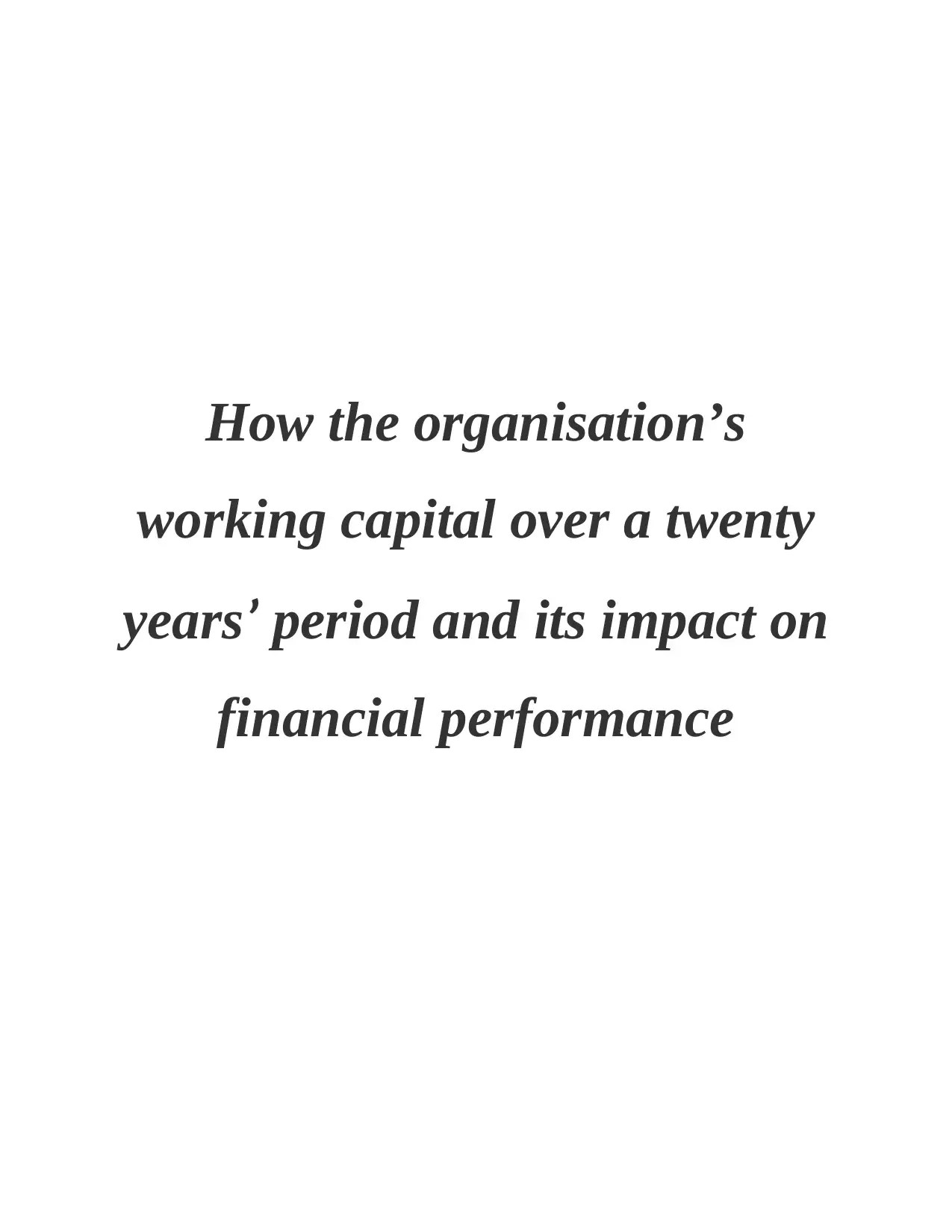
How the organisation’s
working capital over a twenty
years’ period and its impact on
financial performance
working capital over a twenty
years’ period and its impact on
financial performance
Paraphrase This Document
Need a fresh take? Get an instant paraphrase of this document with our AI Paraphraser
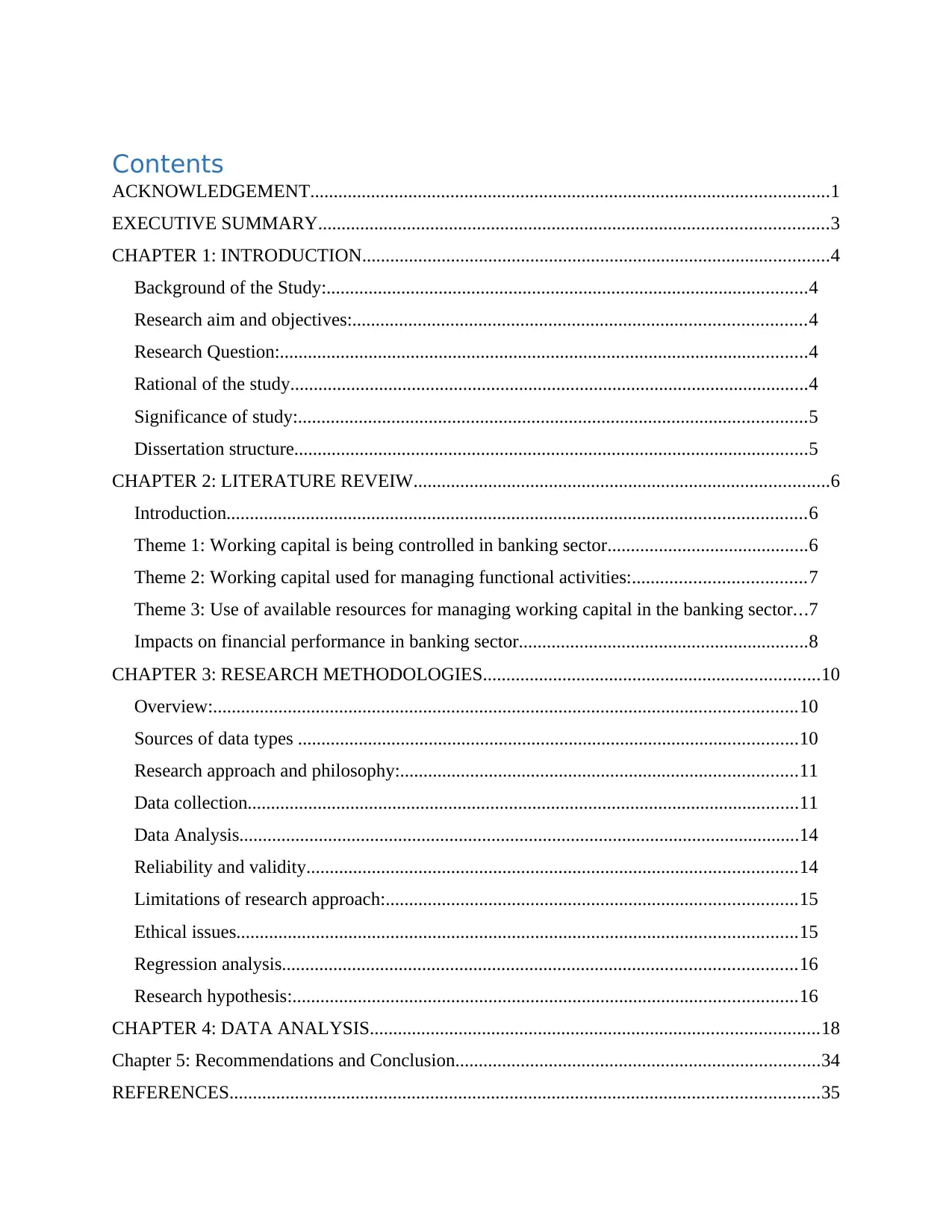
Contents
ACKNOWLEDGEMENT...............................................................................................................1
EXECUTIVE SUMMARY.............................................................................................................3
CHAPTER 1: INTRODUCTION....................................................................................................4
Background of the Study:.......................................................................................................4
Research aim and objectives:.................................................................................................4
Research Question:.................................................................................................................4
Rational of the study...............................................................................................................4
Significance of study:.............................................................................................................5
Dissertation structure..............................................................................................................5
CHAPTER 2: LITERATURE REVEIW.........................................................................................6
Introduction............................................................................................................................6
Theme 1: Working capital is being controlled in banking sector...........................................6
Theme 2: Working capital used for managing functional activities:.....................................7
Theme 3: Use of available resources for managing working capital in the banking sector...7
Impacts on financial performance in banking sector..............................................................8
CHAPTER 3: RESEARCH METHODOLOGIES........................................................................10
Overview:.............................................................................................................................10
Sources of data types ...........................................................................................................10
Research approach and philosophy:.....................................................................................11
Data collection......................................................................................................................11
Data Analysis........................................................................................................................14
Reliability and validity.........................................................................................................14
Limitations of research approach:........................................................................................15
Ethical issues........................................................................................................................15
Regression analysis..............................................................................................................16
Research hypothesis:............................................................................................................16
CHAPTER 4: DATA ANALYSIS................................................................................................18
Chapter 5: Recommendations and Conclusion..............................................................................34
REFERENCES..............................................................................................................................35
ACKNOWLEDGEMENT...............................................................................................................1
EXECUTIVE SUMMARY.............................................................................................................3
CHAPTER 1: INTRODUCTION....................................................................................................4
Background of the Study:.......................................................................................................4
Research aim and objectives:.................................................................................................4
Research Question:.................................................................................................................4
Rational of the study...............................................................................................................4
Significance of study:.............................................................................................................5
Dissertation structure..............................................................................................................5
CHAPTER 2: LITERATURE REVEIW.........................................................................................6
Introduction............................................................................................................................6
Theme 1: Working capital is being controlled in banking sector...........................................6
Theme 2: Working capital used for managing functional activities:.....................................7
Theme 3: Use of available resources for managing working capital in the banking sector...7
Impacts on financial performance in banking sector..............................................................8
CHAPTER 3: RESEARCH METHODOLOGIES........................................................................10
Overview:.............................................................................................................................10
Sources of data types ...........................................................................................................10
Research approach and philosophy:.....................................................................................11
Data collection......................................................................................................................11
Data Analysis........................................................................................................................14
Reliability and validity.........................................................................................................14
Limitations of research approach:........................................................................................15
Ethical issues........................................................................................................................15
Regression analysis..............................................................................................................16
Research hypothesis:............................................................................................................16
CHAPTER 4: DATA ANALYSIS................................................................................................18
Chapter 5: Recommendations and Conclusion..............................................................................34
REFERENCES..............................................................................................................................35

⊘ This is a preview!⊘
Do you want full access?
Subscribe today to unlock all pages.

Trusted by 1+ million students worldwide
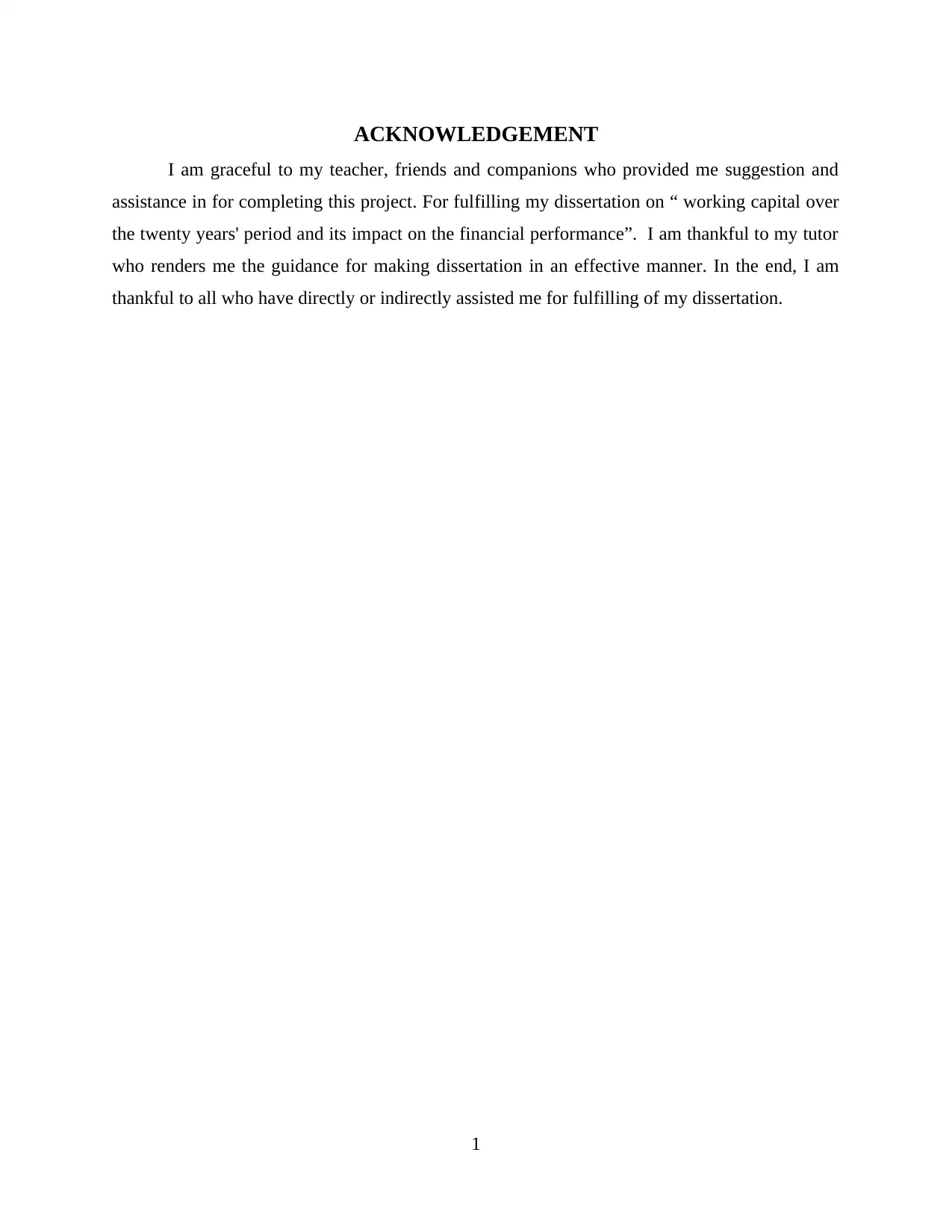
ACKNOWLEDGEMENT
I am graceful to my teacher, friends and companions who provided me suggestion and
assistance in for completing this project. For fulfilling my dissertation on “ working capital over
the twenty years' period and its impact on the financial performance”. I am thankful to my tutor
who renders me the guidance for making dissertation in an effective manner. In the end, I am
thankful to all who have directly or indirectly assisted me for fulfilling of my dissertation.
1
I am graceful to my teacher, friends and companions who provided me suggestion and
assistance in for completing this project. For fulfilling my dissertation on “ working capital over
the twenty years' period and its impact on the financial performance”. I am thankful to my tutor
who renders me the guidance for making dissertation in an effective manner. In the end, I am
thankful to all who have directly or indirectly assisted me for fulfilling of my dissertation.
1
Paraphrase This Document
Need a fresh take? Get an instant paraphrase of this document with our AI Paraphraser
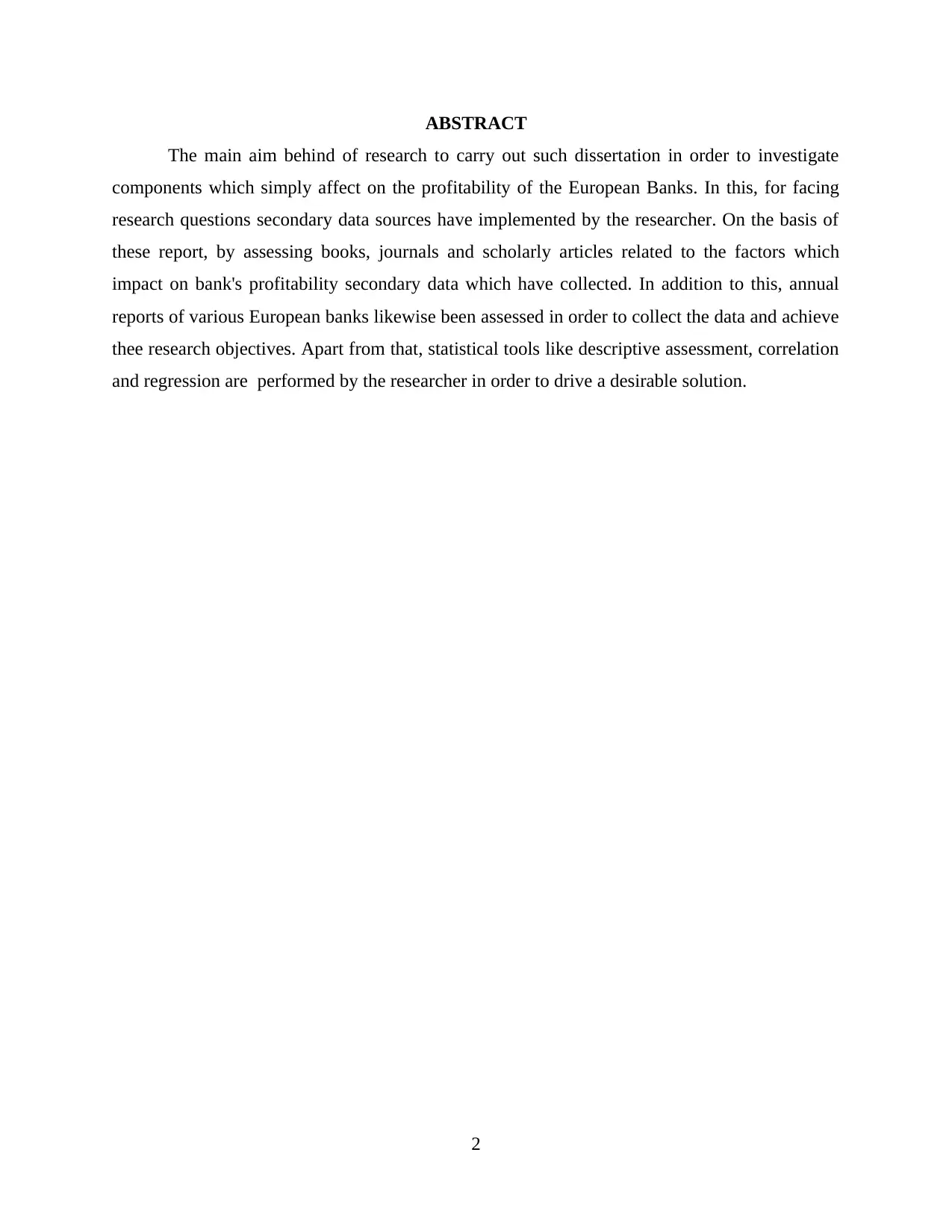
ABSTRACT
The main aim behind of research to carry out such dissertation in order to investigate
components which simply affect on the profitability of the European Banks. In this, for facing
research questions secondary data sources have implemented by the researcher. On the basis of
these report, by assessing books, journals and scholarly articles related to the factors which
impact on bank's profitability secondary data which have collected. In addition to this, annual
reports of various European banks likewise been assessed in order to collect the data and achieve
thee research objectives. Apart from that, statistical tools like descriptive assessment, correlation
and regression are performed by the researcher in order to drive a desirable solution.
2
The main aim behind of research to carry out such dissertation in order to investigate
components which simply affect on the profitability of the European Banks. In this, for facing
research questions secondary data sources have implemented by the researcher. On the basis of
these report, by assessing books, journals and scholarly articles related to the factors which
impact on bank's profitability secondary data which have collected. In addition to this, annual
reports of various European banks likewise been assessed in order to collect the data and achieve
thee research objectives. Apart from that, statistical tools like descriptive assessment, correlation
and regression are performed by the researcher in order to drive a desirable solution.
2

EXECUTIVE SUMMARY
Working capital is the cash amount which is associated to the organisation's routine
operations. There are mainly three essential components which are required to be focused in
order to free up cash otherwise tied up to attain higher cash benefits opportunities, apart from
that, determining in order to assess and managing inefficiencies in processes and manufactures.
More particularly economic turmoil, organisations rely on their cash reserves by way of security.
This is henceforth crucial for the organisation in order to have a strong working capital
management in order to free up the cash from their working capital and enhance their cash
reserves. This would assist them to remain resilient towards unavoidable circumstances like
exchange rate fluctuations, rising interest rates and reducing in sales. If the working capital
position is strong then in that case, Bank could perform better and generate more sales by using
available resources in a most effective manner.
3
Working capital is the cash amount which is associated to the organisation's routine
operations. There are mainly three essential components which are required to be focused in
order to free up cash otherwise tied up to attain higher cash benefits opportunities, apart from
that, determining in order to assess and managing inefficiencies in processes and manufactures.
More particularly economic turmoil, organisations rely on their cash reserves by way of security.
This is henceforth crucial for the organisation in order to have a strong working capital
management in order to free up the cash from their working capital and enhance their cash
reserves. This would assist them to remain resilient towards unavoidable circumstances like
exchange rate fluctuations, rising interest rates and reducing in sales. If the working capital
position is strong then in that case, Bank could perform better and generate more sales by using
available resources in a most effective manner.
3
⊘ This is a preview!⊘
Do you want full access?
Subscribe today to unlock all pages.

Trusted by 1+ million students worldwide

CHAPTER 1: INTRODUCTION
Background of the Study:
This is the research on the firm’s working capital over a twenty-year period and its
impact on the financial performance. Under this research, banking corporation’s working capital
is analysed in an effective manner. By analysing the working capital, various stakeholders can
assess the performance of the organisation in an effective manner (Marr, 2012). This report is
made on the working capital on the banking sector in UK and how it controlled in an effective
manner and it's effect on its performance of the banking sector. Researcher needs to make certain
tools that can be used by the firm for making business decisions in order to frame strategy.
Research aim and objectives:
Aim: “To evaluate the working capital management over the last 20 years and its impact on the
financial performance of banks”.
Objectives:
a) To assess whether capital management has any influence on the solvency of banks.
b) To address the causes of bank suffering or reasons why there are distress in banking
nowadays.
c) To address whether working capital management has any influence on the profitability of
the bank.
d) To how bank manager handle management of the bank.
e) To find out how appropriate is the working capital of the bank.
Research Question:
a). How is working capital being controlled in Banking sector?
b). Is there enough working capital for functional activities in the bank?
c). Do management of bank make an adequate use of available working capital.
Rational of the study
The main aim behind convening current investigating is to elaborating the components
which have influence on the working capital over the last 20 years and its impact on the financial
performance in an effective manner. This is adopted as key issues as after the period of financial
crisis, diverse efforts were formed by the banking companies for enhancement of the monetary
4
Background of the Study:
This is the research on the firm’s working capital over a twenty-year period and its
impact on the financial performance. Under this research, banking corporation’s working capital
is analysed in an effective manner. By analysing the working capital, various stakeholders can
assess the performance of the organisation in an effective manner (Marr, 2012). This report is
made on the working capital on the banking sector in UK and how it controlled in an effective
manner and it's effect on its performance of the banking sector. Researcher needs to make certain
tools that can be used by the firm for making business decisions in order to frame strategy.
Research aim and objectives:
Aim: “To evaluate the working capital management over the last 20 years and its impact on the
financial performance of banks”.
Objectives:
a) To assess whether capital management has any influence on the solvency of banks.
b) To address the causes of bank suffering or reasons why there are distress in banking
nowadays.
c) To address whether working capital management has any influence on the profitability of
the bank.
d) To how bank manager handle management of the bank.
e) To find out how appropriate is the working capital of the bank.
Research Question:
a). How is working capital being controlled in Banking sector?
b). Is there enough working capital for functional activities in the bank?
c). Do management of bank make an adequate use of available working capital.
Rational of the study
The main aim behind convening current investigating is to elaborating the components
which have influence on the working capital over the last 20 years and its impact on the financial
performance in an effective manner. This is adopted as key issues as after the period of financial
crisis, diverse efforts were formed by the banking companies for enhancement of the monetary
4
Paraphrase This Document
Need a fresh take? Get an instant paraphrase of this document with our AI Paraphraser
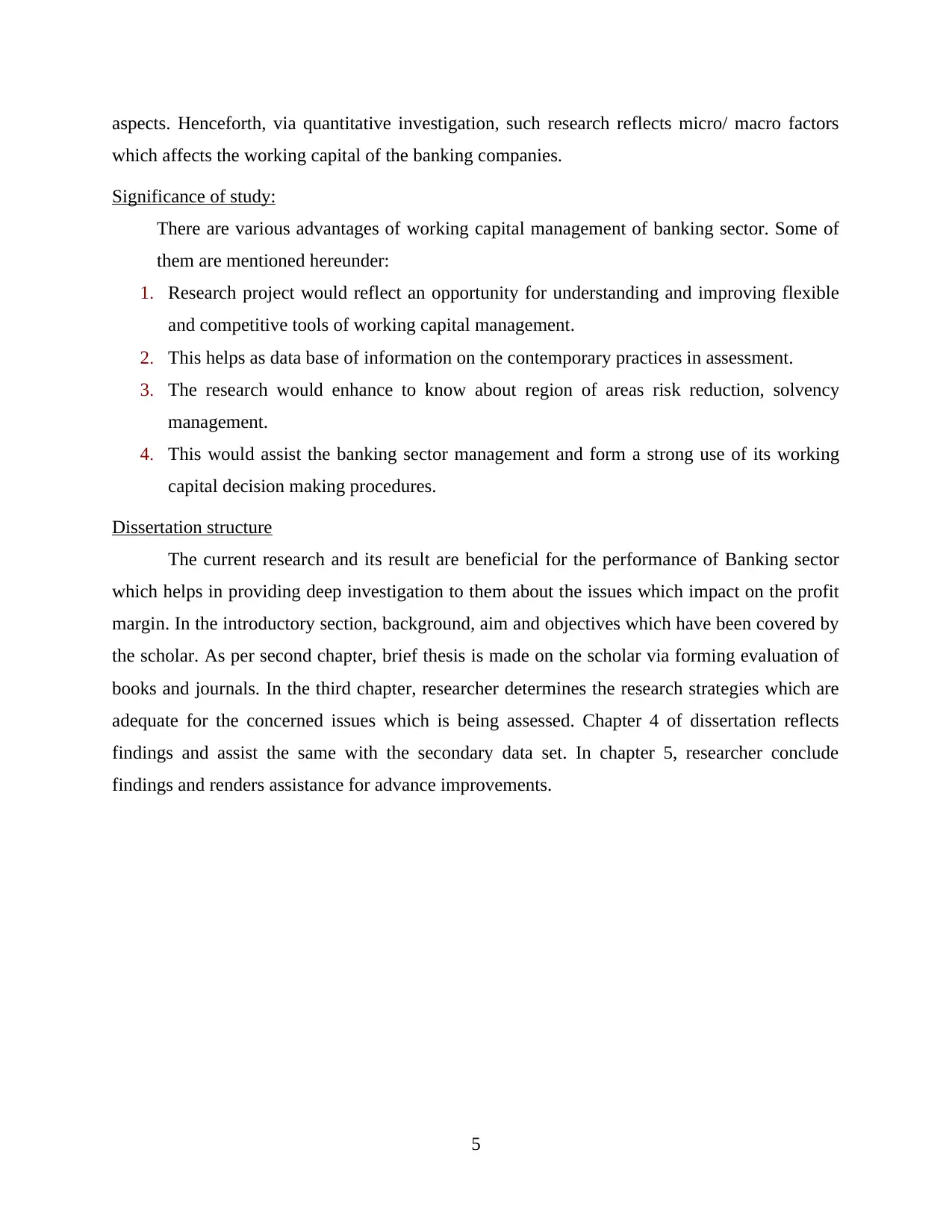
aspects. Henceforth, via quantitative investigation, such research reflects micro/ macro factors
which affects the working capital of the banking companies.
Significance of study:
There are various advantages of working capital management of banking sector. Some of
them are mentioned hereunder:
1. Research project would reflect an opportunity for understanding and improving flexible
and competitive tools of working capital management.
2. This helps as data base of information on the contemporary practices in assessment.
3. The research would enhance to know about region of areas risk reduction, solvency
management.
4. This would assist the banking sector management and form a strong use of its working
capital decision making procedures.
Dissertation structure
The current research and its result are beneficial for the performance of Banking sector
which helps in providing deep investigation to them about the issues which impact on the profit
margin. In the introductory section, background, aim and objectives which have been covered by
the scholar. As per second chapter, brief thesis is made on the scholar via forming evaluation of
books and journals. In the third chapter, researcher determines the research strategies which are
adequate for the concerned issues which is being assessed. Chapter 4 of dissertation reflects
findings and assist the same with the secondary data set. In chapter 5, researcher conclude
findings and renders assistance for advance improvements.
5
which affects the working capital of the banking companies.
Significance of study:
There are various advantages of working capital management of banking sector. Some of
them are mentioned hereunder:
1. Research project would reflect an opportunity for understanding and improving flexible
and competitive tools of working capital management.
2. This helps as data base of information on the contemporary practices in assessment.
3. The research would enhance to know about region of areas risk reduction, solvency
management.
4. This would assist the banking sector management and form a strong use of its working
capital decision making procedures.
Dissertation structure
The current research and its result are beneficial for the performance of Banking sector
which helps in providing deep investigation to them about the issues which impact on the profit
margin. In the introductory section, background, aim and objectives which have been covered by
the scholar. As per second chapter, brief thesis is made on the scholar via forming evaluation of
books and journals. In the third chapter, researcher determines the research strategies which are
adequate for the concerned issues which is being assessed. Chapter 4 of dissertation reflects
findings and assist the same with the secondary data set. In chapter 5, researcher conclude
findings and renders assistance for advance improvements.
5

CHAPTER 2: LITERATURE REVEIW
Introduction
Management of working capital consists of handling of current assets and current
liabilities along with which two key goals, which is to enhanced the banks growth and liquidity
position during the time. Management of working capital is crucially important to an
organisation which is due with growth and financial stability. This lower the opportunity costs
which linked with investing in stock and account receivables and also from managing cash.
Apparently, organisations is requires to have close monitoring on each components of working
capital (Ozkan, Cakan and Kayacan, 2017).
These are the components which are used by the management accountant in order to
optimise the uses of various available resources.
Theme 1: Working capital is being controlled in banking sector
According to Smets, (2014), the effect of working capital management on the overall
relevance of banking industries is very wide as they are assist in controlling valuable information
of various transactions. It has been noticed that management of working capital aims to control
balance between every components those are affecting performance of European banks. In
addition to this, working capital management is concerned to the soundness and administration
of cash flows during the time. They are required to determine effect of creditor, cash and stock
management on financial performance of banking industry.
According to Arko, (2012), they observed that management of working capital refers to
the social control of current assets and current liabilities for handling an optimum levels of
diverse factors those are associated with banking business. Various tools that are helpful for
management to manage working capital and its three key components cash, receivables and
inventories in appropriate manner.
As DUALE, (2016), advocates for bank to concentrate optimise growth and incorporates
optimum utilization of cash resources available to them. While during the time, it is considering
economies to cash holding without impairing entire solvency needs of the banking sector. For
operating financial base of banks are permanently related to working capital that must need to be
funded by equity capital or other long term sources. While on the other hand, temporary working
capital is required to the finance through short term sources of finance (Islam and et.al., 2017). It
6
Introduction
Management of working capital consists of handling of current assets and current
liabilities along with which two key goals, which is to enhanced the banks growth and liquidity
position during the time. Management of working capital is crucially important to an
organisation which is due with growth and financial stability. This lower the opportunity costs
which linked with investing in stock and account receivables and also from managing cash.
Apparently, organisations is requires to have close monitoring on each components of working
capital (Ozkan, Cakan and Kayacan, 2017).
These are the components which are used by the management accountant in order to
optimise the uses of various available resources.
Theme 1: Working capital is being controlled in banking sector
According to Smets, (2014), the effect of working capital management on the overall
relevance of banking industries is very wide as they are assist in controlling valuable information
of various transactions. It has been noticed that management of working capital aims to control
balance between every components those are affecting performance of European banks. In
addition to this, working capital management is concerned to the soundness and administration
of cash flows during the time. They are required to determine effect of creditor, cash and stock
management on financial performance of banking industry.
According to Arko, (2012), they observed that management of working capital refers to
the social control of current assets and current liabilities for handling an optimum levels of
diverse factors those are associated with banking business. Various tools that are helpful for
management to manage working capital and its three key components cash, receivables and
inventories in appropriate manner.
As DUALE, (2016), advocates for bank to concentrate optimise growth and incorporates
optimum utilization of cash resources available to them. While during the time, it is considering
economies to cash holding without impairing entire solvency needs of the banking sector. For
operating financial base of banks are permanently related to working capital that must need to be
funded by equity capital or other long term sources. While on the other hand, temporary working
capital is required to the finance through short term sources of finance (Islam and et.al., 2017). It
6
⊘ This is a preview!⊘
Do you want full access?
Subscribe today to unlock all pages.

Trusted by 1+ million students worldwide
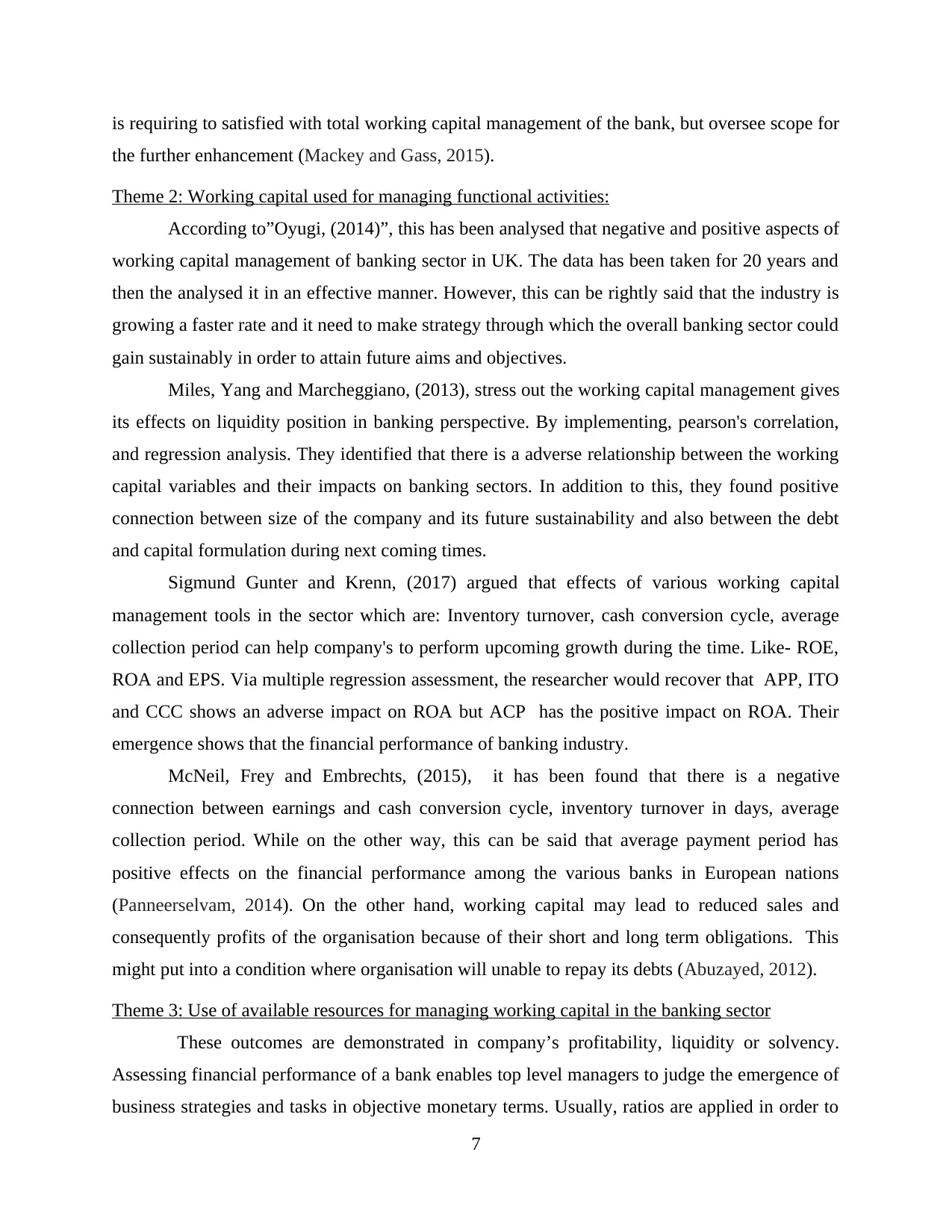
is requiring to satisfied with total working capital management of the bank, but oversee scope for
the further enhancement (Mackey and Gass, 2015).
Theme 2: Working capital used for managing functional activities:
According to”Oyugi, (2014)”, this has been analysed that negative and positive aspects of
working capital management of banking sector in UK. The data has been taken for 20 years and
then the analysed it in an effective manner. However, this can be rightly said that the industry is
growing a faster rate and it need to make strategy through which the overall banking sector could
gain sustainably in order to attain future aims and objectives.
Miles, Yang and Marcheggiano, (2013), stress out the working capital management gives
its effects on liquidity position in banking perspective. By implementing, pearson's correlation,
and regression analysis. They identified that there is a adverse relationship between the working
capital variables and their impacts on banking sectors. In addition to this, they found positive
connection between size of the company and its future sustainability and also between the debt
and capital formulation during next coming times.
Sigmund Gunter and Krenn, (2017) argued that effects of various working capital
management tools in the sector which are: Inventory turnover, cash conversion cycle, average
collection period can help company's to perform upcoming growth during the time. Like- ROE,
ROA and EPS. Via multiple regression assessment, the researcher would recover that APP, ITO
and CCC shows an adverse impact on ROA but ACP has the positive impact on ROA. Their
emergence shows that the financial performance of banking industry.
McNeil, Frey and Embrechts, (2015), it has been found that there is a negative
connection between earnings and cash conversion cycle, inventory turnover in days, average
collection period. While on the other way, this can be said that average payment period has
positive effects on the financial performance among the various banks in European nations
(Panneerselvam, 2014). On the other hand, working capital may lead to reduced sales and
consequently profits of the organisation because of their short and long term obligations. This
might put into a condition where organisation will unable to repay its debts (Abuzayed, 2012).
Theme 3: Use of available resources for managing working capital in the banking sector
These outcomes are demonstrated in company’s profitability, liquidity or solvency.
Assessing financial performance of a bank enables top level managers to judge the emergence of
business strategies and tasks in objective monetary terms. Usually, ratios are applied in order to
7
the further enhancement (Mackey and Gass, 2015).
Theme 2: Working capital used for managing functional activities:
According to”Oyugi, (2014)”, this has been analysed that negative and positive aspects of
working capital management of banking sector in UK. The data has been taken for 20 years and
then the analysed it in an effective manner. However, this can be rightly said that the industry is
growing a faster rate and it need to make strategy through which the overall banking sector could
gain sustainably in order to attain future aims and objectives.
Miles, Yang and Marcheggiano, (2013), stress out the working capital management gives
its effects on liquidity position in banking perspective. By implementing, pearson's correlation,
and regression analysis. They identified that there is a adverse relationship between the working
capital variables and their impacts on banking sectors. In addition to this, they found positive
connection between size of the company and its future sustainability and also between the debt
and capital formulation during next coming times.
Sigmund Gunter and Krenn, (2017) argued that effects of various working capital
management tools in the sector which are: Inventory turnover, cash conversion cycle, average
collection period can help company's to perform upcoming growth during the time. Like- ROE,
ROA and EPS. Via multiple regression assessment, the researcher would recover that APP, ITO
and CCC shows an adverse impact on ROA but ACP has the positive impact on ROA. Their
emergence shows that the financial performance of banking industry.
McNeil, Frey and Embrechts, (2015), it has been found that there is a negative
connection between earnings and cash conversion cycle, inventory turnover in days, average
collection period. While on the other way, this can be said that average payment period has
positive effects on the financial performance among the various banks in European nations
(Panneerselvam, 2014). On the other hand, working capital may lead to reduced sales and
consequently profits of the organisation because of their short and long term obligations. This
might put into a condition where organisation will unable to repay its debts (Abuzayed, 2012).
Theme 3: Use of available resources for managing working capital in the banking sector
These outcomes are demonstrated in company’s profitability, liquidity or solvency.
Assessing financial performance of a bank enables top level managers to judge the emergence of
business strategies and tasks in objective monetary terms. Usually, ratios are applied in order to
7
Paraphrase This Document
Need a fresh take? Get an instant paraphrase of this document with our AI Paraphraser
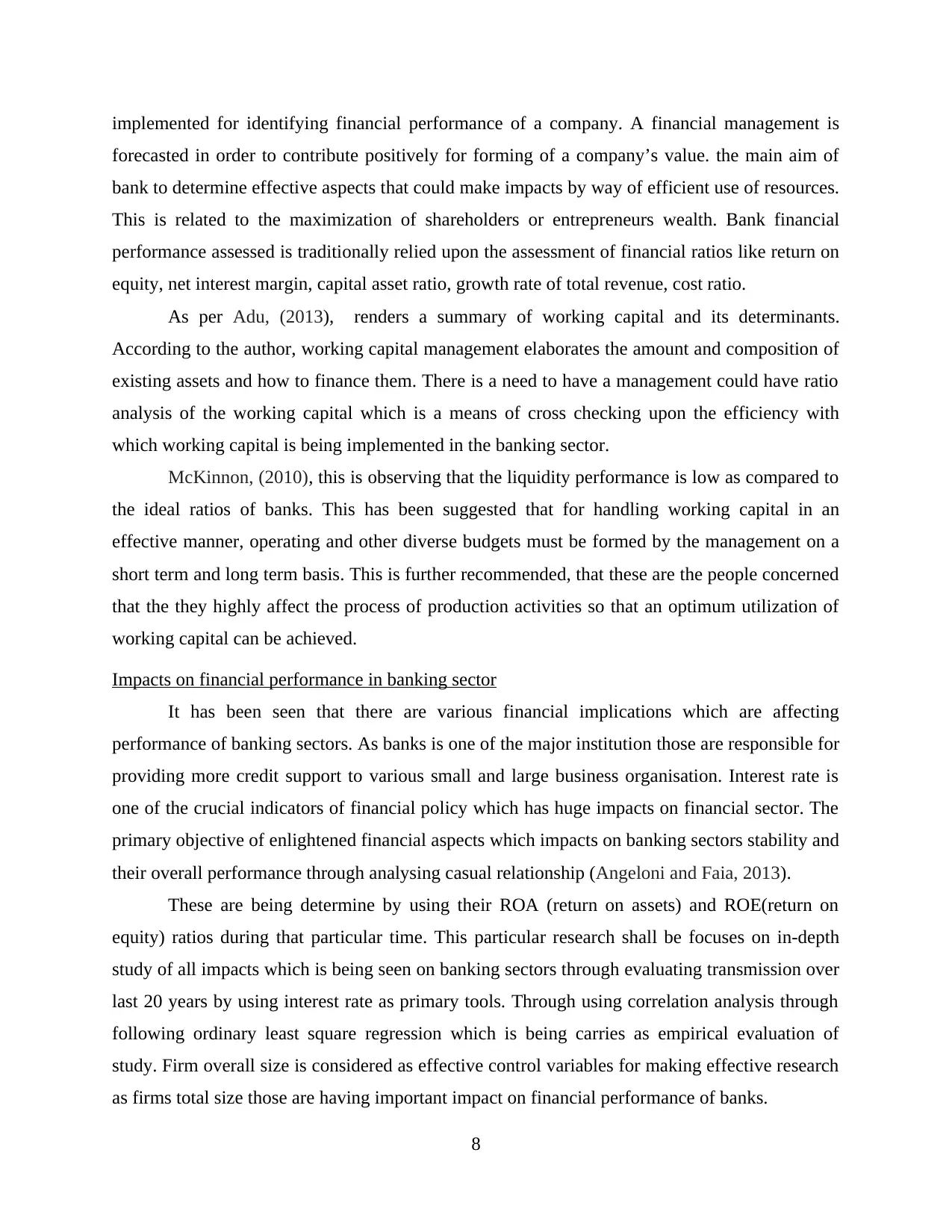
implemented for identifying financial performance of a company. A financial management is
forecasted in order to contribute positively for forming of a company’s value. the main aim of
bank to determine effective aspects that could make impacts by way of efficient use of resources.
This is related to the maximization of shareholders or entrepreneurs wealth. Bank financial
performance assessed is traditionally relied upon the assessment of financial ratios like return on
equity, net interest margin, capital asset ratio, growth rate of total revenue, cost ratio.
As per Adu, (2013), renders a summary of working capital and its determinants.
According to the author, working capital management elaborates the amount and composition of
existing assets and how to finance them. There is a need to have a management could have ratio
analysis of the working capital which is a means of cross checking upon the efficiency with
which working capital is being implemented in the banking sector.
McKinnon, (2010), this is observing that the liquidity performance is low as compared to
the ideal ratios of banks. This has been suggested that for handling working capital in an
effective manner, operating and other diverse budgets must be formed by the management on a
short term and long term basis. This is further recommended, that these are the people concerned
that the they highly affect the process of production activities so that an optimum utilization of
working capital can be achieved.
Impacts on financial performance in banking sector
It has been seen that there are various financial implications which are affecting
performance of banking sectors. As banks is one of the major institution those are responsible for
providing more credit support to various small and large business organisation. Interest rate is
one of the crucial indicators of financial policy which has huge impacts on financial sector. The
primary objective of enlightened financial aspects which impacts on banking sectors stability and
their overall performance through analysing casual relationship (Angeloni and Faia, 2013).
These are being determine by using their ROA (return on assets) and ROE(return on
equity) ratios during that particular time. This particular research shall be focuses on in-depth
study of all impacts which is being seen on banking sectors through evaluating transmission over
last 20 years by using interest rate as primary tools. Through using correlation analysis through
following ordinary least square regression which is being carries as empirical evaluation of
study. Firm overall size is considered as effective control variables for making effective research
as firms total size those are having important impact on financial performance of banks.
8
forecasted in order to contribute positively for forming of a company’s value. the main aim of
bank to determine effective aspects that could make impacts by way of efficient use of resources.
This is related to the maximization of shareholders or entrepreneurs wealth. Bank financial
performance assessed is traditionally relied upon the assessment of financial ratios like return on
equity, net interest margin, capital asset ratio, growth rate of total revenue, cost ratio.
As per Adu, (2013), renders a summary of working capital and its determinants.
According to the author, working capital management elaborates the amount and composition of
existing assets and how to finance them. There is a need to have a management could have ratio
analysis of the working capital which is a means of cross checking upon the efficiency with
which working capital is being implemented in the banking sector.
McKinnon, (2010), this is observing that the liquidity performance is low as compared to
the ideal ratios of banks. This has been suggested that for handling working capital in an
effective manner, operating and other diverse budgets must be formed by the management on a
short term and long term basis. This is further recommended, that these are the people concerned
that the they highly affect the process of production activities so that an optimum utilization of
working capital can be achieved.
Impacts on financial performance in banking sector
It has been seen that there are various financial implications which are affecting
performance of banking sectors. As banks is one of the major institution those are responsible for
providing more credit support to various small and large business organisation. Interest rate is
one of the crucial indicators of financial policy which has huge impacts on financial sector. The
primary objective of enlightened financial aspects which impacts on banking sectors stability and
their overall performance through analysing casual relationship (Angeloni and Faia, 2013).
These are being determine by using their ROA (return on assets) and ROE(return on
equity) ratios during that particular time. This particular research shall be focuses on in-depth
study of all impacts which is being seen on banking sectors through evaluating transmission over
last 20 years by using interest rate as primary tools. Through using correlation analysis through
following ordinary least square regression which is being carries as empirical evaluation of
study. Firm overall size is considered as effective control variables for making effective research
as firms total size those are having important impact on financial performance of banks.
8
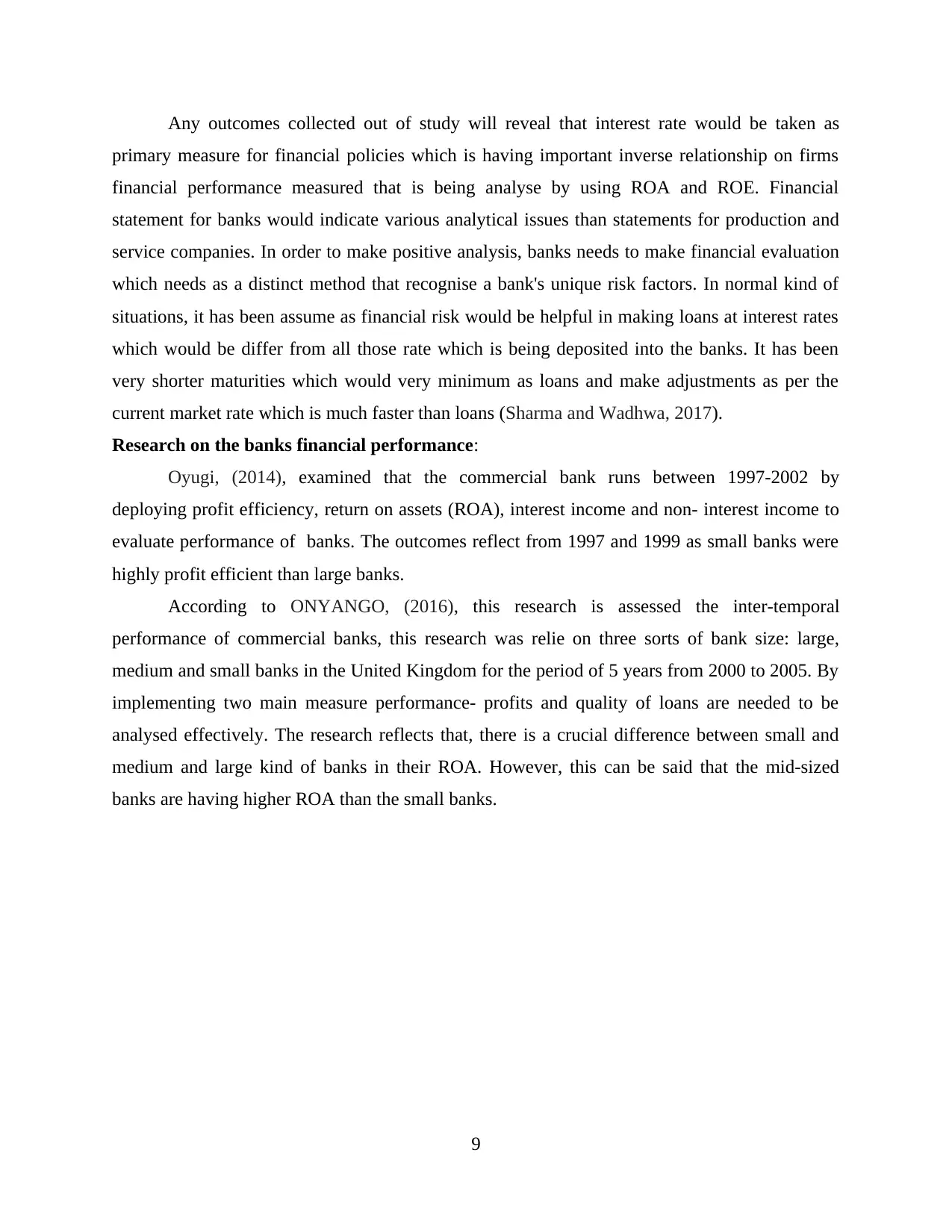
Any outcomes collected out of study will reveal that interest rate would be taken as
primary measure for financial policies which is having important inverse relationship on firms
financial performance measured that is being analyse by using ROA and ROE. Financial
statement for banks would indicate various analytical issues than statements for production and
service companies. In order to make positive analysis, banks needs to make financial evaluation
which needs as a distinct method that recognise a bank's unique risk factors. In normal kind of
situations, it has been assume as financial risk would be helpful in making loans at interest rates
which would be differ from all those rate which is being deposited into the banks. It has been
very shorter maturities which would very minimum as loans and make adjustments as per the
current market rate which is much faster than loans (Sharma and Wadhwa, 2017).
Research on the banks financial performance:
Oyugi, (2014), examined that the commercial bank runs between 1997-2002 by
deploying profit efficiency, return on assets (ROA), interest income and non- interest income to
evaluate performance of banks. The outcomes reflect from 1997 and 1999 as small banks were
highly profit efficient than large banks.
According to ONYANGO, (2016), this research is assessed the inter-temporal
performance of commercial banks, this research was relie on three sorts of bank size: large,
medium and small banks in the United Kingdom for the period of 5 years from 2000 to 2005. By
implementing two main measure performance- profits and quality of loans are needed to be
analysed effectively. The research reflects that, there is a crucial difference between small and
medium and large kind of banks in their ROA. However, this can be said that the mid-sized
banks are having higher ROA than the small banks.
9
primary measure for financial policies which is having important inverse relationship on firms
financial performance measured that is being analyse by using ROA and ROE. Financial
statement for banks would indicate various analytical issues than statements for production and
service companies. In order to make positive analysis, banks needs to make financial evaluation
which needs as a distinct method that recognise a bank's unique risk factors. In normal kind of
situations, it has been assume as financial risk would be helpful in making loans at interest rates
which would be differ from all those rate which is being deposited into the banks. It has been
very shorter maturities which would very minimum as loans and make adjustments as per the
current market rate which is much faster than loans (Sharma and Wadhwa, 2017).
Research on the banks financial performance:
Oyugi, (2014), examined that the commercial bank runs between 1997-2002 by
deploying profit efficiency, return on assets (ROA), interest income and non- interest income to
evaluate performance of banks. The outcomes reflect from 1997 and 1999 as small banks were
highly profit efficient than large banks.
According to ONYANGO, (2016), this research is assessed the inter-temporal
performance of commercial banks, this research was relie on three sorts of bank size: large,
medium and small banks in the United Kingdom for the period of 5 years from 2000 to 2005. By
implementing two main measure performance- profits and quality of loans are needed to be
analysed effectively. The research reflects that, there is a crucial difference between small and
medium and large kind of banks in their ROA. However, this can be said that the mid-sized
banks are having higher ROA than the small banks.
9
⊘ This is a preview!⊘
Do you want full access?
Subscribe today to unlock all pages.

Trusted by 1+ million students worldwide
1 out of 40
Related Documents
Your All-in-One AI-Powered Toolkit for Academic Success.
+13062052269
info@desklib.com
Available 24*7 on WhatsApp / Email
![[object Object]](/_next/static/media/star-bottom.7253800d.svg)
Unlock your academic potential
Copyright © 2020–2025 A2Z Services. All Rights Reserved. Developed and managed by ZUCOL.





